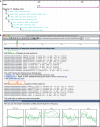dictyBase--a Dictyostelium bioinformatics resource update
- PMID: 18974179
- PMCID: PMC2686522
- DOI: 10.1093/nar/gkn844
dictyBase--a Dictyostelium bioinformatics resource update
Abstract
dictyBase (http://dictybase.org) is the model organism database for Dictyostelium discoideum. It houses the complete genome sequence, ESTs and the entire body of literature relevant to Dictyostelium. This information is curated to provide accurate gene models and functional annotations, with the goal of fully annotating the genome. This dictyBase update describes the annotations and features implemented since 2006, including improved strain and phenotype representation, integration of predicted transcriptional regulatory elements, protein domain information, biochemical pathways, improved searching and a wiki tool that allows members of the research community to provide annotations.
Figures



References
-
- Gaudet P, Fey P, Chisholm RL. Emerging Model Organisms. Cold Spring Harbor, NY: Cold Spring Harbor Laboratories Press; 2008. Dictyostelium discoideum: The Social Amoeba. - PubMed
-
- Ogawa S, Yoshino R, Angata K, Iwamoto M, Pi M, Kuroe K, Matsuo K, Morio T, Urushihara H, Yanagisawa K, et al. The mitochondrial DNA of Dictyostelium discoideum: complete sequence, gene content and genome organization. Mol. Gen. Genet. 2000;263:514–519. - PubMed
-
- Urushihara H, Morio T, Tanaka Y. The cDNA sequencing project. Methods Mol. Biol. 2006;346:31–49. - PubMed
Publication types
MeSH terms
Substances
Grants and funding
LinkOut - more resources
Full Text Sources
Other Literature Sources

